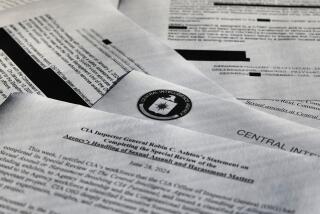A wider torture loophole?
- Share via
I SAT IN A federal courthouse in Raleigh, N.C., for three days watching the trial of CIA contractor David A. Passaro, the first and, so far, only individual connected with the CIA to be charged with abusing a detainee in U.S. custody. Passaro was implicated in the June 2003 death of Abdul Wali at an Army base in Asadabad, Afghanistan. The trial revealed little about Wali, other than he turned himself in to U.S. forces because he had heard they wanted to question him about a rocket attack on the base. Three days later, he was dead.
Passaro was one of his interrogators. U.S. soldiers testified that Passaro kicked Wali in the groin and repeatedly beat him, at times with a metal flashlight, over a period of two days. Prosecutors said Wali pleaded to be shot to end his pain. A jury on Thursday found Passaro guilty of four counts of assault.
Although the conviction is a welcome change from the culture of impunity that has generally prevailed with respect to detainee abuse, it doesn’t ensure that other detainees in U.S. custody won’t face the same fate as Wali.
That’s because the CIA wasn’t on trial in Raleigh, and it is still unclear whether the agency now has a blanket ban on subjecting detainees to abuse. Without that clarity, CIA interrogators will continue to cross the line, and feel that they are justified in doing so. The CIA needs to tell its employees in no uncertain terms that cruel or degrading treatment is forbidden, period.
Last year, enacting Sen. John McCain’s anti-torture measure, Congress attempted to draw a clear line between acceptable and unacceptable treatment of prisoners for anyone acting in the name of the United States. Now the Bush administration wants to blur the line and possibly erase it. The administration proposes to amend the 10-year-old War Crimes Act to weaken the Geneva Convention’s prohibitions against cruel, humiliating and degrading treatment. If the administration succeeds in changing the definition of cruel treatment, it would send soldiers and civilians like Passaro the wrong message about acceptable conduct.
The truth is, since 9/11, a lack of clarity compounded by a series of ambiguous administration memos effectively gave the CIA permission to abuse detainees. In March 2002, the CIA approved a set of harsh interrogation policies -- including “waterboarding,” which makes a person feel as if he is drowning -- for use on high-level Al Qaeda suspects. And by December 2002, the CIA was reportedly operating secret detention centers where some of the harshest interrogation techniques were allegedly used on prisoners.
Nevertheless, CIA officials -- disguised with wigs and mustaches -- testified at Passaro’s trial that they had in no way authorized his abuses. And prosecutors introduced a December 2002 CIA memo they said showed that Passaro’s acts were clearly not authorized. The memo instructed CIA officials in Afghanistan that “when CIA officers are involved in interrogation of a detainee, the conduct ... should not encompass any significant physiological aspects (e.g., direct physical contacts, unusual mental duress, unusual physical restraints or deliberate environmental deprivations) -- beyond those reasonably required to ensure the safety and security of our officers and to prevent the escape of the detainee -- without prior and specific headquarters guidance.”
That memo may have helped convict Passaro, and it prevented him from arguing that he was acting within bounds. But on a closer look, it also showed just how murky the rules of interrogation were. The exception in the memo -- that the prohibitions could be overridden if a senior official gave the OK -- has never before been made public and creates a loophole large enough to drive a truck through.
Congress and the Supreme Court have made it clear that there is a baseline standard of humane treatment below which no person can fall. If the administration gets its way with its legislative proposals, though, we will have both less clarity and possible authorization for the CIA to use techniques that do not meet even minimal humane treatment requirements. Until every agency of the U.S. government trains its personnel to the standard required by law, there will be more deaths of detainees in custody.
More to Read
Sign up for Essential California
The most important California stories and recommendations in your inbox every morning.
You may occasionally receive promotional content from the Los Angeles Times.













